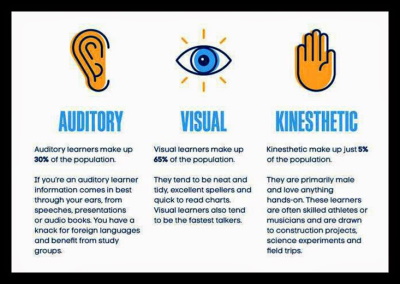Written by: Rebecca Sprengel
As online learning has largely taken over from face to face classes, we can rely on even less information on how our students learn, especially in a one-to-one situation. Do some students benefit more than others from on-line learning?
In this two-part article, I would like to look at learning styles models and discover solutions to facilitate learning in an online environment.
Even the classical VAK (Visual, Auditory, Kinesthetic) learning styles model is not much help when staring at a student on your screen for 60 minutes. What do you think? How about sharing your experience, thoughts and tips in our new forum/chat in the Members Only area of the ELTAS website. You’ll also find a copy of the VAK questionnaire there in the handout section or the chatroom.
Only a few lucky people find learning easy. One of the main reasons is that most of us have been used to being taught in the same standard way.
Let’s begin by defining learning: the process of acquiring new knowledge, understanding and skills.
There is an important connection between learning and emotions. If you are learning something in a way that suits your learning style, you will experience positive emotions and learning will be more effective. I am sure you have all seen students’ mixed reactions when you tell them: “Now we are going to do a listening exercise.”
Some sit up and smile enthusiastically, while others roll their eyes and groan, and I find it amusing how some intensely stare at the device from which the dialogue is coming from, as if this would help comprehension. Are some of them Auditory while the others are Visual?
In order to maximize learning styles in an EFL classroom, a teacher should be aware of learning style paradigms, know how to effectively assess their students’ learning styles, and develop lessons that take this information into account.
For a long time, researchers have made efforts to define and categorize learning styles in different ways. Peacock (2001) experimented on 206 EFL students and 46 EFL teachers at a Hong Kong university to prove that “all students have their own learning styles and learning strengths and weaknesses”, and “a mismatch between teaching and learning styles causes learning failure, frustration, and demotivation.”
On the other hand, many educational psychologists have shown that there is little evidence for the efficacy of most learning style models, and furthermore, that the models often rest on dubious theoretical grounds.
I have found learning styles to be helpful in designing courses for managers, by getting them to take the test and discuss their results – in English of course. Some have even given the test to their children who were having problems at school.
Moving on from the VAK model, there are several theories on leaning styles. My favourite is the Honey and Mumford learning style.
Peter Honey and Alan Mumford are best known for their learning style questionnaire. This self-administered questionnaire determines your preferred learning style. Their work is inspired from and built upon Kolb’s learning styles model. However, they produced their own Learning Styles Questionnaire (LSQ) because it was found that Kolb’s model had low validity with executives and managers.
Honey and Mumford devised a questionnaire that probes general behavioural tendencies. Their reasoning is most people have never consciously considered how they really learn. Knowing your learning style can also help avoid repeating mistakes by undertaking activities that strengthen other styles For example, if you tend to “jump in at the deep end”, consider spending time reflecting on experiences before taking action. They also postulate that people prefer different methods of learning, depending upon the situation and their experience level, thus they move between the four modes of learning, rather than being dominantly locked into one mode.
Although teachers might sometimes stereotype or misinterpret when assessing students’ learning styles, the potential benefits of using learning style based methods in an EFL classroom should encourage teachers to consider students’ preferences and make lesson plans based on careful assessment of their students learning styles. I would further suggest that we, as teachers have our own preferred style which might influence our choice of material.
In the follow-up article to be published in September, I would like to present Honey and Mumford’s theories, share useful links for the test, and draw – hopefully helpful – conclusions.
About our author:
A British national from London, Rebecca has lived and worked in many countries for over 30 years. She now works mainly as a personal language, communication and cross-cultural coach for top-management and multi-national teams. She is also an author and presenter. Rebecca has a B.Sc. in psychology and adult education and a B.A. in applied modern languages from the Sorbonne, Paris. She also has a Post Graduate Certificate in Coaching and Mentoring Practice from Oxford Brookes University. Totally tri-lingual – English, French and German – she combines academic and business achievements with pragmatic hands-on experience. Rebecca was on the ELTAS committee in the 90ies, BESIG chair for 3 years and spent several years on the EMCC Board (European Mentoring and Coaching Council). Learning, networking and sharing expertise are just some of the reasons why she’s also a member of the current committee. Are you interested in contributing an article to our website or helping out the news team? Contact Rebecca at




No Comments Yet